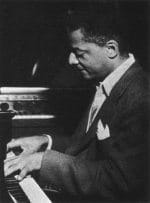Teddy Wilson

A seminal figure in the swing to bop movement, Teddy Wilson is known for his lightly swinging, effervescent style; a precursor and inspiration for the styles of later pianists such as Hank Jones, and Ahmad Jamal. Born in Austin, Texas in 1912, the son of school teachers, Wilson studied his musical craft at Tuskegee Institute and the Talladega College in Alabama. He traveled through Ohio, and Detroit with the bands of Speed Webb, and Milton Senior. Chicago brought engagements with Jimmy Noone’s group, Louis Armstrong, Erskine Tate and others. He joined Benny Carter’s ensemble the Chocolate Dandies in 1933, which Carter left to function as an arranger for Benny Goodman. Wilson joined vibraphonist Red Norvo, Willie Bryant in 1935, and later worked with Goodman.
Wilson’s association with Goodman is notable because he was involved in the groundbreaking practice of a racially integrated band, being it’s first black member. Wilson ventured to record his own small groups within this period with such greats as Lester Young on tenor, Roy Eldridges trumpet, vocalist Lena Horne and trumpeter Harry James. Wilson led noteworthy sessions with Billie Holiday also, and was present at Goodman’s legendary 1938 Carnegie Hall concert. Departing from Goodman in 1939, forming his own orchestra with talents including tenor saxophone innovator Ben Webster and trumpeter Doc Cheatham. Wilson’s lightly swinging style was dismissed as being a bit too sweet and “white”, and the group quickly dissolved making way for a six year run from 1940-46 at the Cafe Society.
Additional highlights in Wilson’s career include working at CBS Radio recording a number of sides making up The Teddy Wilson School of Piano , and a seven year term at Julliard, as one of the first Jazz musicians to join the faculty in the fifties. Verve issued recordings featuring Wilson as sideman with Lester Young and Benny Carter, recorded as a leader for Columbia, and was a part of Benny Goodman‘s orchestra for his tour of Russia.
Wilson was prolific through the seventies prior to his death in 1986. His influence was very evident in the aforementioned styles of Jamal, Hank Jones and can be very much felt on the Prestige recordings of the Red Garland trio, although Garland’s playing frequently showcased a heavier bebop sensibility. Though his touch was light, with fine left hand comping, Wilson was often hard swinging, playing concise solos cutting right to the point. Teddy Wilson continues to make for intriguing study today for historians, and musicians alike.
I have been the staff writer for the New York Jazz Workshop School of Music blog in midtown Manhattan since 2014, and that has broadened my freelance writing skills considerably. In addition to writing artist bios, and articles of interest that pertain to the mission of the school, I have interviewed (in print on the site) legendary guitarist and NEA Jazz Master Pat Metheny, trumpeter Cuong Vu, and in 2015 embarked on producing a podcast for the school where I have achieved my dream and interviewed jazz giants such as Dave Liebman, Lenny White, rising talents like Thana Alexa, Logan Richardson, guitarist and bassist Brian Kastan, among others. I also work on SEO optimization for the blog. In 2015 I started my blog Jazz Views with CJ Shearn, and have written liner notes for 5 time Grammy winner and Oscar and Golden Globe nominee, Antonio Sanchez (for his latest recording “Channels of Energy”) and guitarist Gene Ess for his latest recording, scheduled to be released in November 2018.
My passion for jazz music is what drives me, which is an interest I’ve had since I can remember. I initially began writing about jazz at the age of 13 for my high school newspaper, and in my late teens contributed occasionally to jazzreview.com. In college I was member of the Harpur Jazz Project which brought jazz acts to campus. I’ve also contributed in the past to AllAboutJazz where I was mentored by John Kelman. I decided to focus on my passion for jazz music journalism after a job in the social services field as a caseworker went south, and as a person with a physical disability I work on going against the odds, living independently and having accomplished things people had said I’d never do.
